NEWS FROM FDIC INTERNATIONAL 2015
FDIC International 2015, held April 20-25 in Indianapolis, once again was a record-breaking conference. Following are some of the highlights. Full show coverage that includes reports on Hands-On-Training and classroom presentations; the messages of Education Director and Editor in Chief of Fire Engineering Bobby Halton and the keynote speakers; the presentations of the Ray Downey Courage and Valor Award, the Tom Brennan Lifetime Achievement Award, and the Fire Engineering/ISFSI George D. Post Instructor of the Year Award; and, of course, the latest in technology, innovation, and newly available products and services offered by the exhibitors is available at https://www.fdic.com/coverage/more-fdic-coverage.html.
Sean Killelea is 2015 Ray Downey Courage and Valor Award Recipient
Captain Sean Killelea, of the Warren Township (IN) Fire Department, was awarded the 2015 Ray Downey Courage and Valor Award, which memorializes the name and legacy of Deputy Chief Ray Downey of the Fire Department of New York, one of the greatest fire service leaders of our time.
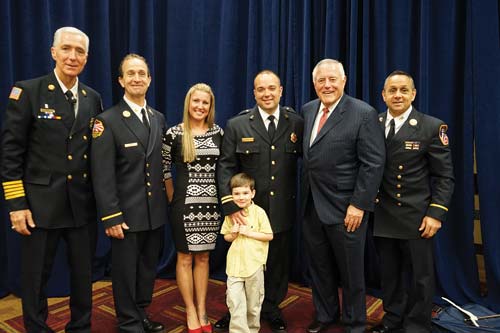 |
| (1) After the award presentation. (l-r): Chief Bobby Halton, Battalion Chief Chuck Downey, Sean Killelea and family, CEO of PennWell Publishing Corp. Robert Biolchini, and Battalion Chief Joseph Downey. (Photos by Tony Greco.) |
“Captain Sean Killelea exemplified the highest traditions of the fire service by risking his life to rescue a fellow firefighter. His courage, perseverance, and selfless efforts are to be honored for directing the valiant rescue of Firefighter Matt O’Donnell,” said Robert F. Biolchini, CEO of PennWell Publishing Corp., who presented Killelea with the Courage and Valor medal and a $35,000 check from the Fire Engineering Courage and Valor Foundation. FDNY Battalion Chiefs Joe and Chuck Downey, sons of Ray Downey, and Bobby Halton, editor in chief of Fire Engineering and FDIC International education director, also participated in the presentation. National Fallen Firefighters Foundation Director Ron Siarnicki and National Fire Academy Alumni Association President Ron Kanterman, who are also members of the Courage and Valor Selection Committee, were also on stage.
Killelea responded with Squad 18 as mutual aid to assist the New Carlisle (IN) Fire Department for a reported commercial fire. Killelea, Squad 18 leader, and Squad 18 members Firefighters Jay Pendergrass and Aaron Carsten were assigned as the rapid intervention team for a Mayday call involving a partial collapse of the burning structure and the entrapment of New Carlisle Fire Department Assistant Chief Jamie Middlebrook and Firefighter Matt O’Donnell. The trio entered the structure under heavy fire conditions and with zero visibility. The east wall of the collapse was fully involved in fire. The building was coming down around them. They were able to locate and rescue O’Donnell; at that time, they were not aware that Middlebrook, who perished in this fire, was still inside the fire building, which had totally collapsed.
Peters receives Tom Brennan Lifetime Achievement Award
William C. Peters was awarded the 2015 Tom Brennan Lifetime Achievement Award at Thursday’s General Session. Peters retired from the Jersey City (NJ) Fire Department after 28 years of service. As a battalion chief, Peters was appointed apparatus supervisor and went on to become an expert in acquiring and maintaining apparatus and equipment.
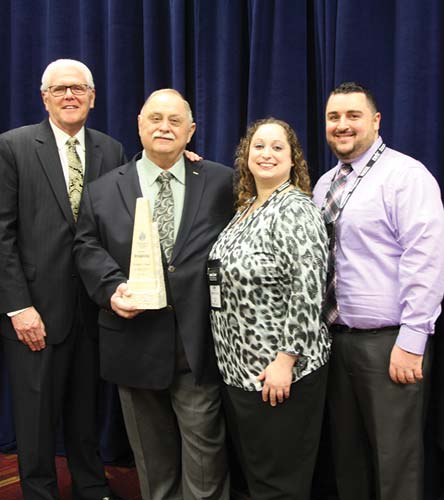 |
| (2) (l-r) National Fire Academy Superintendent Denis Onieal, Bill Peters, Meri Peters, and Mike Tuohey. |
He has guided hundreds of fire departments in developing specifications when purchasing new apparatus and in maintaining them. He has been a staunch advocate for improved firefighter safety. Tom Brennan, for whom the award was named, was the editor in chief of Fire Engineering for eight years and a technical editor. He had more than 35 years of fire service experience, including more than 20 years with the Fire Department of New York and five years as chief of the Waterbury (CT) Fire Department. He was the recipient of the 1998 Fire Engineering Lifetime Achievement Award.
Buchanan named George D. Post Instructor of the Year
Division Chief Eddie Buchanan, of Hanover (VA) Fire & EMS, received the 2015 Fire Engineering (FE)/International Society of Fire Service Instructors (ISFSI) George D. Post Instructor of the Year Award at Thursday’s General Session. Steve Pegram, president of the ISFSI, and Bobby Halton, editor in chief of Fire Engineering and education director of FDIC International, were the presenters.
Pegram cited Buchanan, who has been a member of the fire service since 1982, for “working a problem and finding a solution.” Buchanan’s most recent contribution to the fire service is the SLICE-RS acronym, originally designed to help his department deal with modern fire problems.
George D. Post, a long-time member of the ISFSI, was a member of the Fire Department of New York and a developer of instructional materials. He is considered the “father of visual materials” used to train fire service personnel around the world.
Halton: “Become exemplary human beings who just happen to be firefighters”
Chief Bobby Halton motivated the full-capacity audiences at the Opening Ceremony and General Session with moving, dynamic messages that challenged attendees to uphold the ideals and standards that have made the fire service viable and respected throughout its existence. On Wednesday, Halton stressed the words Duty, Honor, and Country in the context in which they were spoken by U.S. Army General Douglas MacArthur in 1962. “These three hallowed words reverently dictate what you ought to be, what you can be, and what you will be.” Halton urged fire service members to build and maintain a vision of what it means to be a public servant and of what they may become in the future and to “move beyond the occupation of firefighting seeking to be exemplary human beings who just happen to be firefighters.”
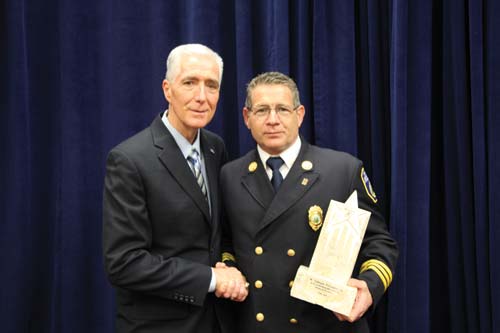 |
| (3) Chief Bobby Halton and Eddie Buchanan. |
Thursday, Halton focused on the role of instructors/leaders in the fire service; the influences of instructors on their firefighter students; and the interrelationship among firefighters, educators, and the community. Instructors/leaders, he said, must have and uphold the heroic dream and bold vision of a day when “firefighters will not have to weigh their commitment to our sacred mission when, through training and education, they will never again find themselves in a situation where they will have to risk the time they have left for another.”
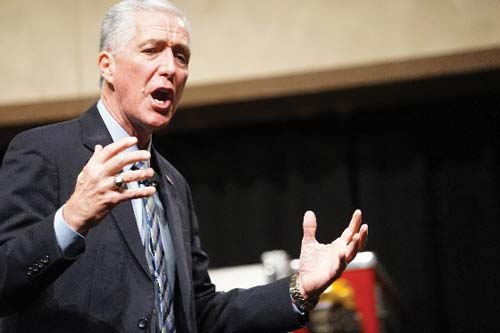 |
| (4) Chief Halton stresses one of his primary points. |
“By your presence here today, you have shown you are self-aware, you recognize your strengths and weaknesses, you are ready for challenges and opportunities, you are creative and innovative,” Halton told attendees. “By your presence here today, you have demonstrated you are ready to share bold dreams and to dare to dream of a day when no firefighter will have to weigh his/her commitment to offer his/her last full measure.” That day may come after your lifetime, Halton noted, but nonetheless “you will be remembered, maybe not by name, but as instructors/leaders who stood tall and made a difference.”
Kerber: “The more I learned, the more I learned what I did not know.”
Wednesday’s keynote speaker Stephen Kerber tackled the long-standing issues that contribute to the complexity of the fire service, especially when it comes to tactical options. Kerber, director of the UL Firefighter Safety Research Institute, noted that at times it is difficult to determine whom firefighters should listen to, and why. Kerber said that his experience has been: “The more I learned, the more I learned what I did not know.”
Noting that it is not surprising that there is more than one side to many of the issues relating to firefighting tactics because “everyone has their own experience and forms opinions from them,” Kerber explained that these circumstances have led him to “learn more and have an open mind.” He revealed that he, himself, has questions that need answering.
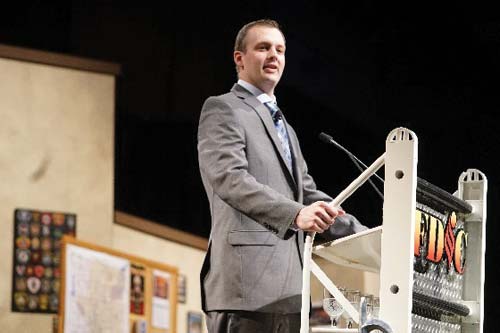 |
| (5) Stephen Kerber: “We have yet to run a series of experiments where we were not surprised by some of the outcomes.” |
“The great thing about science,” he related, “is that once you understand how things work, you can understand things you have not experienced yet.” The question he posed for the audience was, “Shouldn’t we be trying to learn everything we can so that we are doing the best thing possible when called to do so?” In the experiments UL undertakes, Kerber said, “We have yet to run a series of experiments where we were not surprised by some of the outcomes.” The tests undertaken are accomplished with firefighters from across the country, who ask the questions and design the experiments, he explained.
He urged the audience to work together to “create a legacy of intelligent professionals, critically thinking firefighters who will continually work to get better.”
DeCrane: “How do we improve our work environment if we are not involved in how it is designed, constructed, and maintained?”
Keynote speaker Sean DeCrane, on Thursday, shared with the audience how after years of searching, pondering, commiserating, attending funerals of firefighters killed in the line of duty, and personal soul searching, he came to realize that a large component of firefighter safety is monitoring the “work environment”-the structures in which firefighters will fight fires and mitigate other types of emergencies.
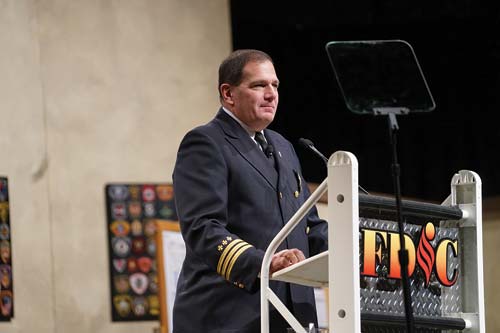 |
| (6) Sean DeCrane: “Imagine what a little activism can do to protect your work environment!” |
For DeCrane, who began his fire service career in 1991 with the Cleveland (OH) Division of Fire, this has meant becoming deeply involved with building codes. The death of Lt. Arnie Wolff in a fire in a house built with lightweight construction in Green Bay, Wisconsin, in 2006 was a driving factor in DeCrane’s tireless efforts to show the relationship between codes and firefighter safety. The National Institute for Occupational Safety and Health noted in its fatality report for Wolff that codes were needed to protect firefighters from this type of construction.
DeCrane made a startling revelation when he first entered the code arena: “What I found was a group of individuals who have never fought a fire working on codes that established our work environment. It was an awakening moment,” he said. He asked the audience, “How do we improve our work environment if we are not involved in how it is designed, constructed, and maintained?”
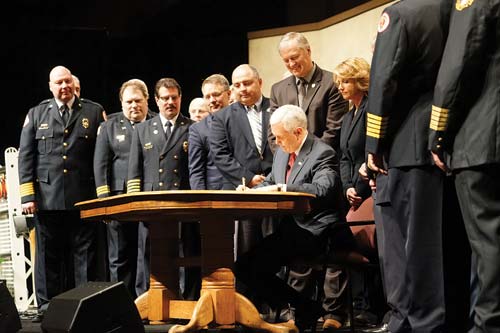 |
| (7) Indiana Governor Michael Pence signs the bill creating the Indiana Fire Training Academy as the bill’s sponsors and supporters look on. The facility will offer standardized training, have quality assurance as a priority, foster consistency in training, and have the training continue at district training centers, Pence noted. |
He realized that firefighters’ becoming active in the codes process and passing code language requiring protection from lightweight construction in one- and two-family homes would improve safety for firefighters operating on the fireground. However, many firefighters are not familiar with their local codes or are not aware when passed codes are weakened by political influence in their jurisdictions. He challenged the audience: “Imagine what a little activism can do to protect your work environment.”
DeCrane proposed that firefighters strive to become “well-rounded,” which, he explained, includes “working on all facets of your game-suppression, education, training, community risk reduction, code involvement, and public education-becoming the most valuable resource your community has.”

